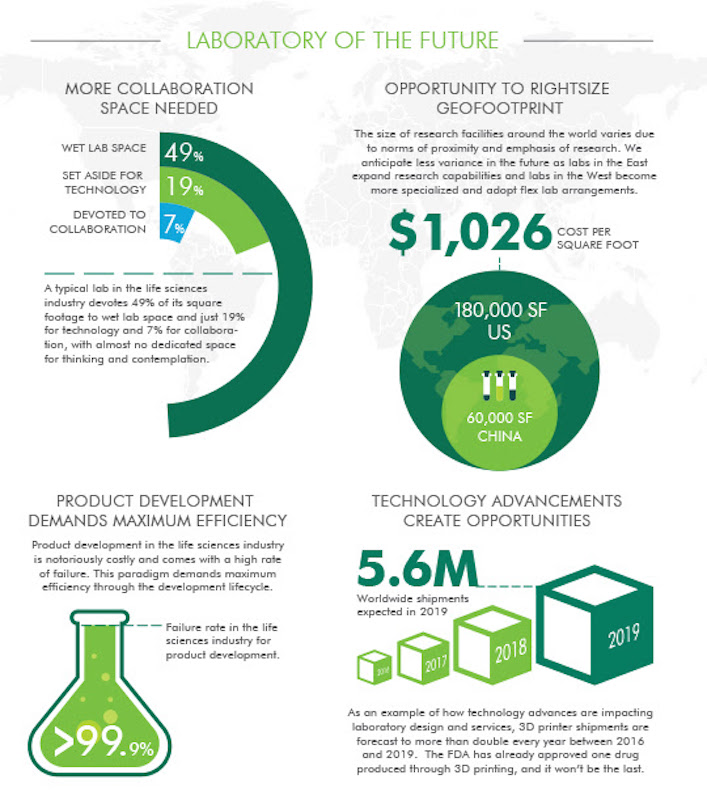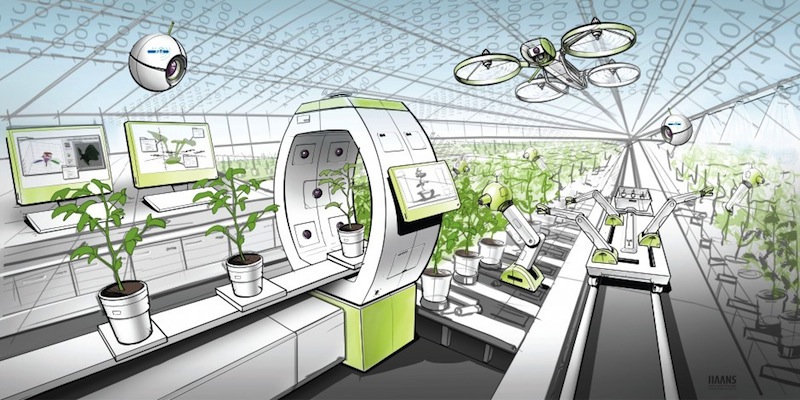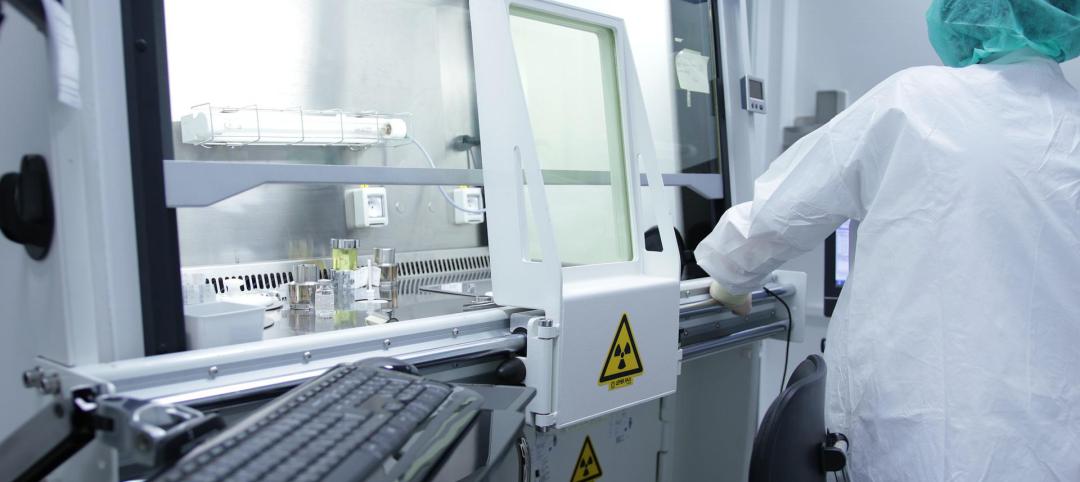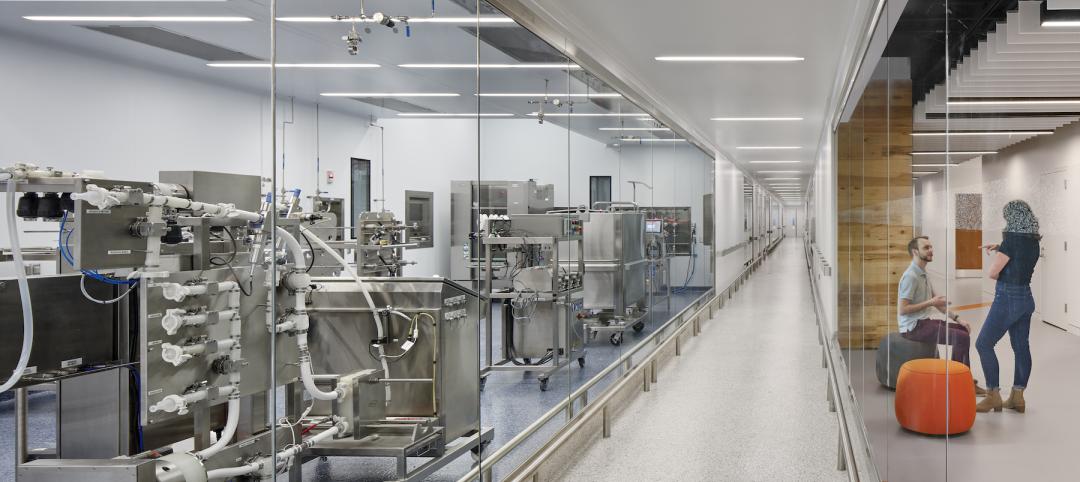Lab design has failed to keep pace with scientific advances and the changing needs of researchers. If, as expected, the next generation ushers in significant revolutions in the ways science is conducted, then lab design and operations, and the ways that scientists interact with these environments, will be at the heart of this change.
That is the scenario CBRE Global Workplace Solutions lays out in a just-released report, “Lab of the Future,” authored by Gregory Weddle, CBRE’s Vice President of Innovation and Products; and Hannah Hahn, its Global Workplace Innovation Manager.
The report draws heavily from a benchmarking study of labs that CBRE completed in 2014, which collected data from 24 labs in three global regions across four leading pharmaceutical companies. The report also reflects more than 68 lab professionals who responded to a questionnaire and contributed qualitative data on occupancy, instrumentation, spatial use, and collaborative space.
There are several reasons why labs need fresh design approaches. The era of the blockbuster drug discovery is past, and long-term trends lean toward personalized care, data-driven discovery, and digitization of lab spaces. “Hyper-flexible spaces that can be reconfigured as needs change will become more important.”
In addition, R&D is moving to lower-cost countries and to be closer to new markets. By 2025, two thirds of the world’s population could be living in Asia. Per-capita health spending in these markets today is significantly below Western levels. “The ability to collaborate quickly and efficiently among global locations will be more vital than ever.”
Indeed, CBRE sees organizations placing far more emphasis on speed to market and maximizing the use cost for their research facilities. “There is intense scrutiny on the return on investment for all R&D projects.”

Future labs need to be adaptable to changing technologies, and be set up to deliver products quicker to market. Image: CBRE Global Workplace Solutions
CBRE says that, at the very least, organizations with lab space should be asking themselves:
• Does your organization have many large molecule products in its pipeline?
• Is your science focus changing?
• Is your organization well-funded?
• Is your organization able to attract the scientists it requires in timely fashion?
• How willing is my organization to adopt new processes?
“Business strategy, therefore, must drive laboratory strategy,” CBRE concludes.
Among the trends that the CBRE’s report cites include digital lab space, which reflects the new generation of researchers known as digital natives, who are accustomed to digital technology having grown up with it. Social technology is changing communication patterns within labs, leading to flatter structures based on specialty interests. And given that only 7% of current lab space is set aside for collaboration, future labs must allocate more area for researcher collaboration, enabled by technology and design concepts.
Standardization could be a key to making labs more efficient and amenable, says CBRE. “Modular planning principles will be used to create a collaborative, flexible lab floorplan that can be used as a rotating lab,” the report states. “This means each lab space must be essentially the same size to allow for changes in lab furniture, bench space and overall layout. Today’s (and tomorrow’s) labs are aided by the ability to prefabricate building elements.”
Other factors influencing the shifting utilization of lab space include the miniaturization of equipment, which has been going on for a while, and helps to make researchers more productive in less floor space. Automation and robotics, so-called “shy” technology that’s barely noticeble (such as devices that communicate with each other), 3D printing, and artificial intelligence will all play roles in lab design and space utilization.
CBRE points out that, as life sciences become more technologically focused, labs must be set up to handle the greater volumes of data. Currently about 20% of lab space is set aside for technology, and that will need to increase significantly over the next 25 years.
And adept, skilled facilities managers will be in demand to keeping labs functional. “Put simply, as the physical location of the lab and all of its equipment become more fluid, a team that keeps track of utilization, operation, and maintenance of equipment will play an important role,” the report states.
Related Stories
Data Centers | Nov 28, 2022
Data centers are a hot market—don't waste the heat!
SmithGroup's Brian Rener shares a few ways to integrate data centers in mixed-use sites, utilizing waste heat to optimize the energy demands of the buildings.
School Construction | Oct 31, 2022
Claremont McKenna College science center will foster integrated disciplinary research
The design of the Robert Day Sciences Center at Claremont McKenna College will support “a powerful, multi-disciplinary, computational approach to the grand socio-scientific challenges and opportunities of our time—gene, brain, and climate,” says Hiram E. Chodosh, college president.
Higher Education | Oct 24, 2022
Wellesley College science complex modernizes facility while preserving architectural heritage
A recently completed expansion and renovation of Wellesley College’s science complex yielded a modernized structure for 21st century STEM education while preserving important historical features.
Laboratories | Oct 5, 2022
Bigger is better for a maturing life sciences sector
CRB's latest report predicts more diversification and vertical integration in research and production.
Laboratories | Sep 12, 2022
Lab space scarcity propels construction demand in life sciences sector
In its 2021 Life Sciences Real Estate Outlook, JLL predicted that access to talent would be a primary concern for an industry sector that had been growing by leaps and bounds. A year later, talent still guides real estate decisions. But market conditions of a different sort were cooling the biotech field: namely, investors that have soured on startups which underperformed after going public. What this means for new construction and renovation going forward is unpredictable, as the drivers behind life sciences’ surge are still palpable.
| Sep 2, 2022
New UMass Medical School building enables expanded medical class sizes, research labs
A new nine-story, 350,000 sf biomedical research and education facility under construction at the University of Massachusetts Chan Medical School in Worcester, Mass., will accommodate larger class sizes and extensive lab space.
Giants 400 | Aug 22, 2022
Top 70 Science + Technology Facility Contractors + CM Firms 2022
Whiting-Turner, Hensel Phelps, DPR Construction, and Skanska USA top the rankings of the nation's largest science and technology (S+T) facility contractors and construction management (CM) firms, as reported in Building Design+Construction's 2022 Giants 400 Report.
Giants 400 | Aug 22, 2022
Top 70 Science + Technology Facility Engineering + EA Firms 2022
Jacobs, CRB, Fluor, and Affiliated Engineers Inc. head the rankings of the nation's largest science and technology (S+T) facility engineering and engineering/architecture (EA) firms, as reported in Building Design+Construction's 2022 Giants 400 Report.
Giants 400 | Aug 22, 2022
Top 100 Science + Technology Facility Architecture + AE Firms 2022
HDR, Flad Architects, Gensler, and DGA top the rankings of the nation's largest science and technology (S+T) facility architecture and architecture/engineering (AE) firms, as reported in Building Design+Construction's 2022 Giants 400 Report.
Giants 400 | Aug 22, 2022
Top 45 Laboratory Facility Contractors and Construction Management Firms for 2022
Whiting-Turner, Hensel Phelps, McCarthy, and STO Building Group top the ranking of the nation's largest science and technology (S+T) laboratory facility contractors and construction management (CM) firms, as reported in Building Design+Construction's 2022 Giants 400 Report.

















